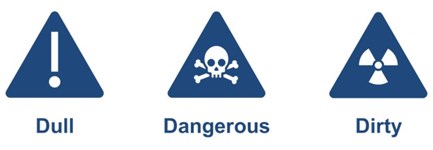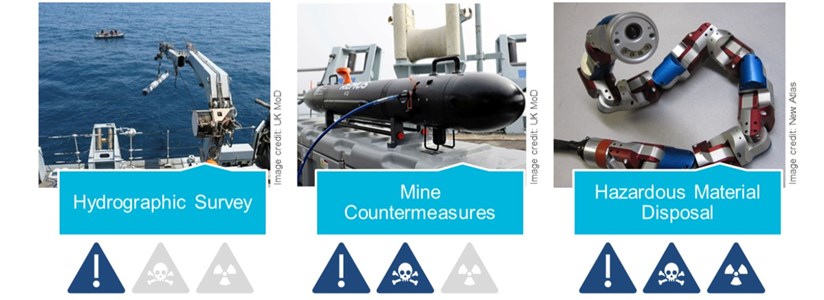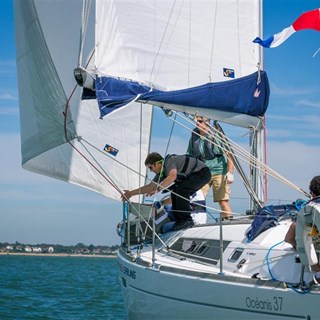
11 September 2023
In the rapidly advancing world of robotics, the three Ds—Dull, Dirty, and Dangerous—have long been used to describe the tasks that robots are uniquely suited to handle. From monotonous assembly line work to hazardous bomb investigations, robots have proven their worth by taking on these repetitive, dirty, and perilous jobs. However, with the rise of marine autonomy, we are witnessing an evolution of these traditional roles. The emergence of new technologies and capabilities has given birth to the 6 Ds of marine autonomy: Dull, Dirty, Dangerous, Deep, Dear, and Duration.

Let's delve into each of these dimensions to understand the transformative potential of marine autonomy.
Dull: Robots have excelled at taking over mundane and repetitive tasks, freeing up human workers to focus on more creative and stimulating endeavors. Whether it's within warehouse fulfillment centers, hotels, hospitals, or various other workplaces, robots have effectively eliminated tedium and often resulted in cost savings.
Dirty: Many crucial jobs, mostly unknown to the average person, require handling tasks that are unclean and messy. Robots are perfect substitutes for humans in such scenarios, whether it's sewer reconnaissance, cow milking, or mine exploration. Major mining companies have invested in extensive robot programs, such as robo-trucks, to perform dirty jobs efficiently.
Dangerous: Robots have already been deployed in dangerous military situations, space exploration missions, and bomb investigations and detonations. The use of robots in security and police work is also on the rise, by deploying robots in high-risk situations, we can protect human lives and enhance overall safety.

Deep: The term "deep" has been in use for almost a decade, primarily within the scientific community such as the National Oceanography Centre (NOC) (Deep Platforms, 2023). It refers to cost-effective deep-water exploration and the ability to design submersibles without the need for a central pressure vessel to sustain human life at these depths. The success of robotic submarines like Nereus, which reached the bottom of the Mariana Trench (Nereus, 2009), and remotely controlled submersibles surveying the Titanic wreckage showcases the potential of deep-sea exploration through robotics.
Dear: Proposed by Andrew McAfee and Erik Brynjolfsson in their book "Machine, Platform, Crowd: Harnessing Our Digital Future (Brynjolfsson & McAfee, 2017)," the concept of "dear" refers to the potential cost savings and reduced delays achieved through robotic deployment. For example, robots can be used to monitor construction project sites, resulting in considerable time and financial savings. However, integrating autonomous systems into operations often requires adopting new business models.
Duration: The concept of duration is intricately linked to the "dull" aspect, particularly in cases where long-term watchkeeping is required. Scientific and military communities have explored the benefits of long-duration missions, including improved surveillance, reconnaissance, and surveying capabilities. By eliminating the need for life support systems and focusing solely on fuel, robots can operate for extended periods without interruption.
Long duration has two interesting use cases, anti-submarine warfare (ASW) and anti-air warfare (AAW). If an autonomous long duration vessel is integrated into a taskforce this enables the below scenarios:

These examples show how ASW and AAW could be completed differently, possibly with a more persistent, efficient capability at a reduced danger to life and reduced cost.
As we explore the 6 Ds of marine autonomy, several key questions arise. What is the operating scenario? Can marine autonomy deliver valuable mission capabilities? Is it cost-effective? Can it contribute to the growth of the naval fleet? Autonomy can’t solve all problems, you can read more about the drawbacks and the benefits in our paper ‘The Highly Autonomous Warship’. Full consideration of the use case and technologies are crucial for beneficial implementation of marine autonomy.
In conclusion, as technology advances and the role of autonomy continues to evolve, the requirements for marine autonomy are increasing and additional benefits are emerging. Utilising a proficient command & control hub, such as a Highly Autonomous Warship, can provide effective management of autonomous systems. By embracing full autonomy, we can add mass to the fleet, improving task force endurance, performance, and the quality of life for naval personnel. However, the challenges must be addressed to fully realise the potential of marine autonomy.
The era of marine autonomy is upon us, and by embracing the 6 Ds, we can revolutionise industries, improve safety, and unlock unprecedented possibilities in the world's oceans.
References
Brynjolfsson, E., & McAfee, A. (2017). Machine, Platform, Crowd: Harnessing the Digital Revolution: Harnessing Our Digital Future. W. W. Norton & Company.
Deep Platforms. (2023). Retrieved from Natonal Oceanography Centre: https://noc.ac.uk/facilities/marine-autonomous-robotic-systems/deep-platforms
Nereus. (2009, June 4). Retrieved from Woods Hole Oceanographic Institution: https://www.whoi.edu/oceanus/feature/nereus-soars-to-the-oceans-deepest-trench/

Chloe Yarrien is a Maritime Autonomous Systems Engineer at BMT. She graduated Swansea University with a degree in Theoretical Physics before joining QinetiQ to work in mine countermeasures.
Chloe has been at BMT for six years, in which time she has worked on the MoD’s Common Support Model, BMT’s Marine Autonomous Systems Synthetic Environment Assessment Service (SEAS) and as an embedded team member in the MoD Mine Countermeasure and Hydrographic Capability team working on Project Wilton.
Chloe has managed and led a variety of projects and R&D, including thought leadership papers in the autonomy space.

N/A
In a world where complexity is the norm and certainty is rare, adaptability isn’t a luxury, it’s a necessity. And when we combine it with empathy, structure, and a commitment to quality, we create programmes that deliver real, lasting value.

N/A
In a world where complexity is the norm and certainty is rare, adaptability isn’t a luxury, it’s a necessity. And when we combine it with empathy, structure, and a commitment to quality, we create programmes that deliver real, lasting value.

Tim Curtis
Most transformation programmes fail—not because of poor execution, but because they never truly understood the race they were competing in. The BMT Strategy Canvas changes that.

Kathryn Walker
Coaching is a proven tool to support change leaders and their teams. The greatest impact and success has been achieved in transformation programmes, where structural and programmatic approaches are supported by attention to the cultural and behavioural aspects of change.